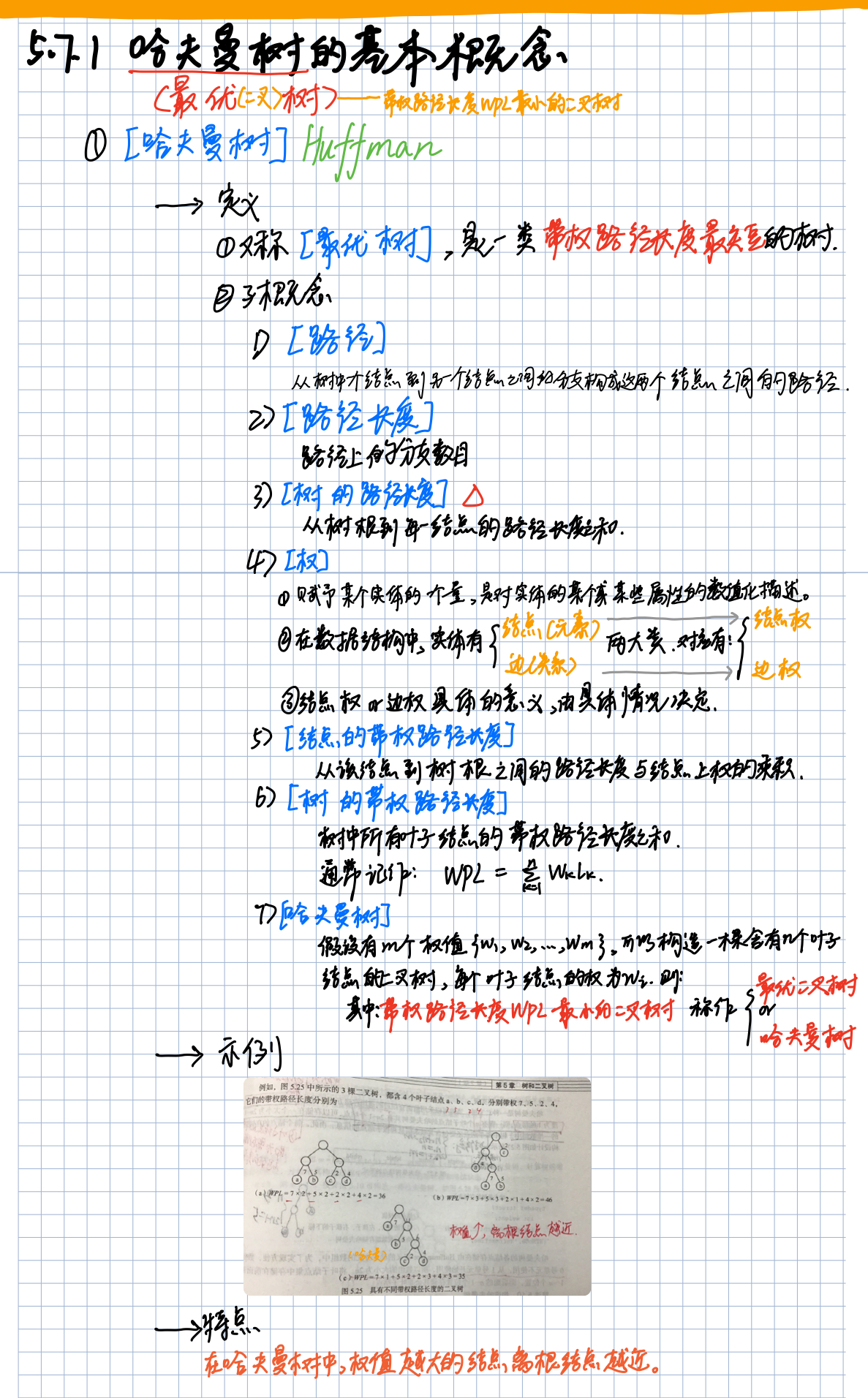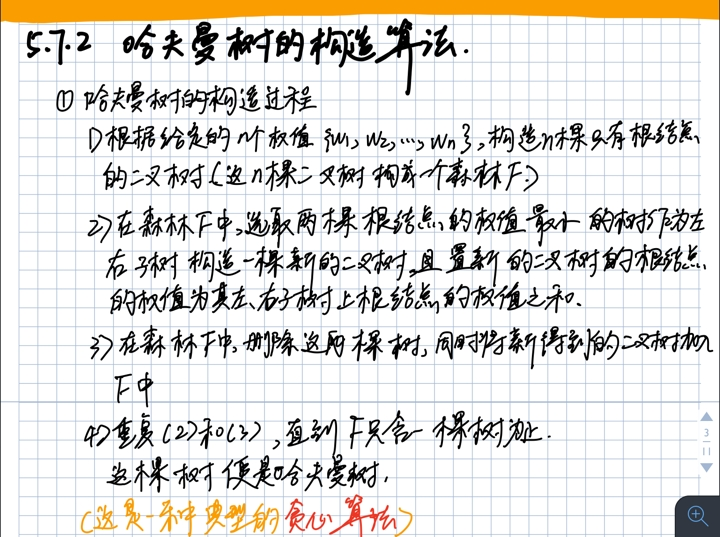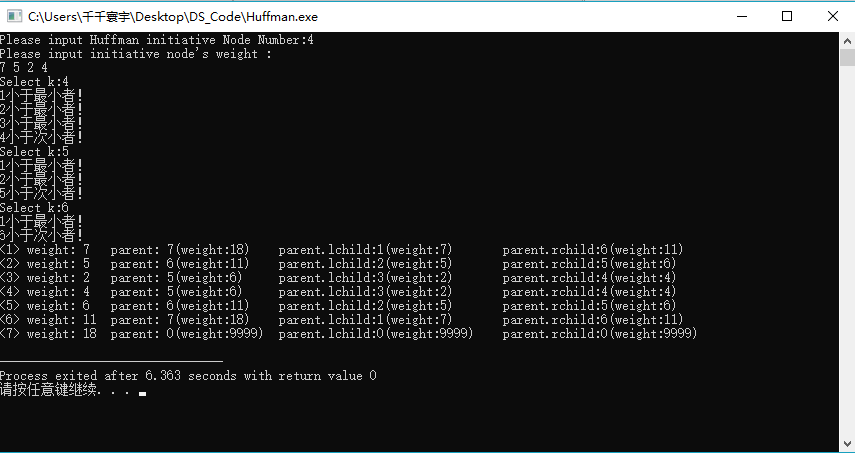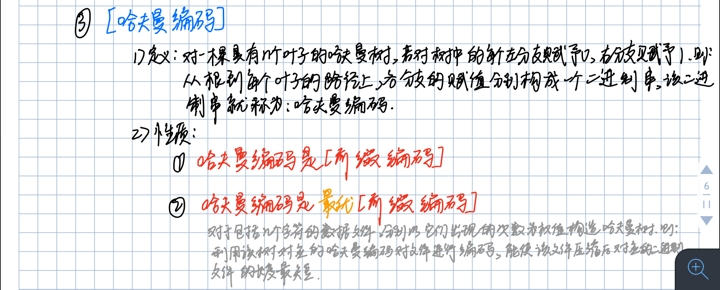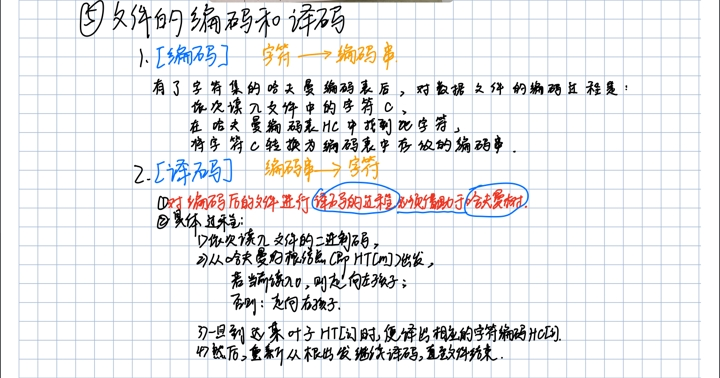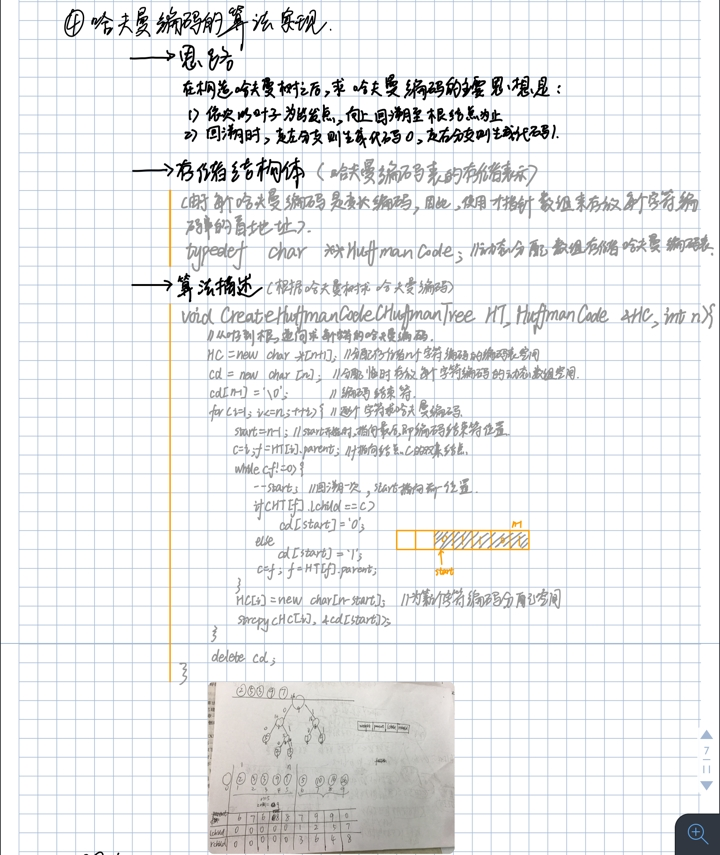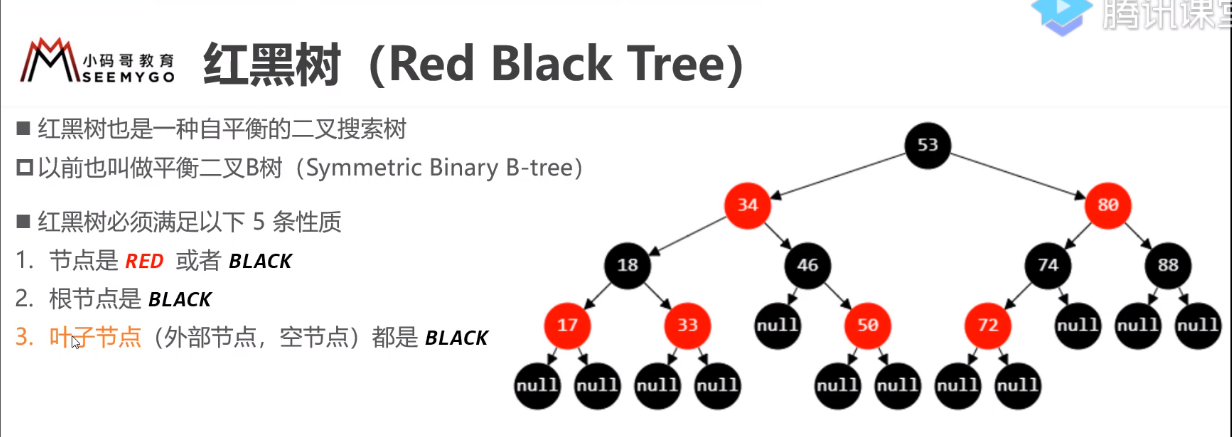一 哈夫曼树
1.1 基本概念
- 算法思想
- 贪心算法(以局部最优,谋求全局最优)
- 适用范围
- 1 【(约束)可行】:它必须满足问题的约束
- 2 【局部最优】它是当前步骤中所有可行选择中最佳的局部选择
- 3 【不可取消】选择一旦做出,在算法的后面步骤中,就无法再改变。
- 示例
- 【树论:最优(二叉)数=带权路径最短的树】
- 【图论:最小(代价)生成树】
- 【图论:单源最短路径=从某一结点出发至其他结点的带权路径之和最小 / 多源最短路径=某一对结点之间的带权路径之和最小】
- 定义
- 哈夫曼树 = 最优((满)二叉)树 = 带权路径之和最短的树
- 哈夫曼树所产生的哈夫曼编码 = (最优)前缀编码
1.2 算法描述/构造过程
1.3 算法实现
# define MAXNEGATIVE -9999 //最大负值
# define MAXPOSITIVE 9999 //最大正值
typedef struct HuffmanNode{ // 加 typedef : 避免发生编译错误 " variable or field 'functionName' declared void "
double weight;
int parent, lchild, rchild; //当前节点的双亲结点、左右孩子结点
}*HuffmanTree;
- 2> 确定最小的两个结点的选择策略(贪婪策略)【次核心】
/**
* 选择权值结点最小的两个结点 s1、s2
*/
void Select(HuffmanTree &HT,int k,int *s1,int *s2){
int min[2]={0, 0}; // 升序排名, 保留 HT中 权重值最小的两个结点的下标
cout<<"Select k:"<<k<<endl;
HT[0].weight = MAXPOSITIVE; // 初始化为最大正值,方便被 初始结点比最小而比下去
for(int i=1;i<=k;i++){
// cout<<"i:"<<i<<" weight:"<<HT[i].weight<<" parent:"<<HT[i].parent<<" parent.weight:"<<HT[HT[i].parent].weight<<endl;
if( HT[i].parent==0 && (HT[i].weight<HT[min[1]].weight)){
if(HT[i].weight<HT[min[0]].weight){ // 小于 最小者
min[1] = min[0]; min[0] = i; cout<<i<<"小于最小者!"<<endl;
} else {
min[1] = i;cout<<i<<"小于次小者!"<<endl; //仅小于 次小者
}
}
}
*s1 = min[0]; // 最小者下标
*s2 = min[1]; // 次小者下标
// cout<<"s1:"<<*s1<<" s2:"<<*s2<<endl;
}
/**
* 创建 Huffman 树
* n : 初试结点(待编码结点)数
*/
void CreateHuffmanTree(HuffmanTree &HT, int n){
int m = 2*n-1;
HT = new HuffmanNode[m+1]; // 0 位空余
cout<<"Please input initiative node's weight : "<<endl; // 输入结点数据
for(int i=1;i<=n;i++){
cin>>HT[i].weight;
}
for(int k=1;k<=m;k++){ // 初始化所有结点
HT[k].lchild = 0;
HT[k].rchild = 0;
HT[k].parent = 0;
}
for(int j=n+1;j<=m;j++){
int s1,s2;
Select(HT, j-1, &s1, &s2); // 选择权值结点最小的两个结点s1、s2
HT[s1].parent = j; // 合并左右结点
HT[s2].parent = j;
HT[j].lchild = s1;
HT[j].rchild = s2;
HT[j].weight = HT[s1].weight + HT[s2].weight;
}
}
void OutputHuffmanTree(HuffmanTree &HT, int n){ // 输出 哈夫曼树 中 结点情况
int m = 2*n-1;
for(int i=1;i<=m;i++){
cout<<"<"<<i<<"> weight: "<<HT[i].weight<<" "<<"parent: "<<HT[i].parent<<"(weight:"<<HT[HT[i].parent].weight<<") ";
cout<<"parent.lchild:"<<HT[HT[i].parent].lchild<<"(weight:"<<HT[HT[HT[i].parent].lchild].weight<<")"<<" ";
cout<<"parent.rchild:"<<HT[HT[i].parent].rchild<<"(weight:"<<HT[HT[HT[i].parent].rchild].weight<<")"<<endl;
}
}
int main(){
HuffmanTree HT;
int n;
cout<<"Please input Huffman initiative Node Number:"; // 输入哈夫曼结点初始结点数目 n
int s1, s2;
cin>>n;
CreateHuffmanTree(HT, n);
OutputHuffmanTree(HT, n);
return 0;
}
二 哈夫曼编码
2.1 哈夫曼编码的主要思想
2.2 【前缀编码】
2.3 【哈夫曼编码】
2.4 应用:文件的编码与译码
2.5 哈夫曼编码的算法实现 (根据哈夫曼树,求哈夫曼编码)
//由于 每个哈夫曼编码是变长编码;因此,使用指针数组来存储每个字符编码串的首地址
typedef char **HuffmanCode; // 动态分配数组,存储哈夫曼编码表 (char 前面不能随意加 struct 关键字)
/**
* 根据哈夫曼树,求哈夫曼编码
*/
void CreateHuffmanCodeByHuffmanTree(HuffmanTree HT, HuffmanCode &HC,int n){//从叶子到根,逆向求每个字符的哈夫曼编码
HC = new char *[n+1]; // 分配存储n个字符编码的编码表空间
char *cd = new char [n]; // 分配临时存放每个字符编码的动态数组空间
cd[n-1] = '�'; // 编码结束符
for(int i=1;i<=n;i++){ // 逐个字符求哈夫曼编码
int start = n-1; // start 初始化指向最后位置 即 编码结束符位置,逆向存储 从叶子到根结点路径的0/1编码
int c = i;
int f = HT[i].parent; // f 指向结点C 的双亲结点
while(f!=0){ // 直到 f 滑动到根节点为止
--start; // 编码表游标向前滑动
if(HT[f].lchild == c){
cd[start] = '0';
} else {
cd[start]= '1';
}
c = f;
f = HT[f].parent; // 逆向, 自(树)底向(树)上
}
HC[i] = new char [n-start]; //为第i个字符编码分配存储空间
strcpy(HC[i], &cd[start]); // 头文件: #include <string.h> 、<stdio.h>
}
delete cd;
}
void OutputHuffmanCodes(HuffmanCode &HC,int n){
for(int i=1;i<=n;i++){
cout<<"第"<<i<<"个哈夫曼编码:";
for(int j=0,size=sizeof(HC[i])/sizeof(char);j<size;j++){
cout<<HC[i][j];
}
cout<<endl;
}
}
int main(){
HuffmanTree HT;
int n;
cout<<"Please input Huffman initiative Node Number:"; // 输入哈夫曼结点初始结点数目 n
int s1, s2;
cin>>n;
CreateHuffmanTree(HT, n);
OutputHuffmanTree(HT, n);
HuffmanCode HC;
CreateHuffmanCodeByHuffmanTree(HT, HC, n);
OutputHuffmanCodes(HC, n);
return 0;
}
三 哈夫曼译(解)码
四 文献
4.1 参考文献
- 《数据结构(C语言版):严蔚敏/吴伟民》
- 《算法设计与分析基础([美] Anany Levitin. 潘彦 译)》
4.2 推荐文献
五 二叉树 补充:红黑树
